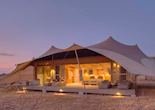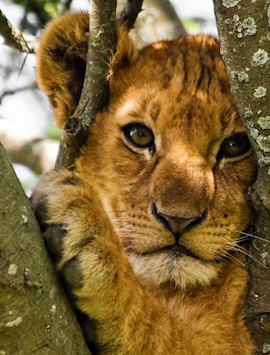

Luxury northern Migration safari
12 days from £11,450pp
- Jump to:
- Itinerary
- Reviews
- When to go
Tour highlights
The specialist who creates your trip

What's included in your Audley booking?






Knowing we’ve taken care of everything
“We know that the small details make all the difference. It’s why we won’t stop finessing your trip until you say it’s just right. From the outset, we’ll focus on bringing the experience you want to life, down to the finest detail."
Itinerary idea
Includes international flights from a choice of UK airports, including London, Birmingham, Manchester, Newcastle, Edinburgh and Glasgow.
-
Today you begin your journey by boarding your international outbound flight to Arusha.
-
You’ll land at Kilimanjaro International Airport today. After clearing immigration and collecting your luggage, your driver will meet you at arrivals and transfer you to your lodge in Arusha. Given its proximity to some of the best national parks in Tanzania, as well as Mount Kilimanjaro, most people visiting this city are here to start an adventure. After a long travel day, you may want to relax, but if you’re interested in seeing more of a city that’s buzzing with excitement, we can arrange a city tour or other experiences for you.
-
You'll have a private guide and vehicle until you fly to the Serengeti later in your trip, and after an early breakfast this morning, you’ll meet your guide. You will set off for Tarangire National Park, often a preferred park among guides due to its size and remoteness, particularly in the southern section. The park is known for the large number of elephants that congregate here. There are substantial populations of wildebeests, zebras, impala, giraffes, elands and buffalo, and even a few localised and unusual species, including the gerenuk and fringe-eared oryx. The primary landscape is dry, open woodland with hundreds of Africa’s prehistoric ‘Trees of Life’, the baobab tree. You’ll explore the park in your private vehicle, stopping for a picnic lunch during your drive, and eventually head to your camp for the evening.
-
You have a full day to explore Tarangire with your guide. One of the appeals of staying in the park rather than visiting for a day trip is the access it provides to the southern section. Many visitors drive around the northern section before continuing their way because going deeper into the park means two extra hours of driving each way. When you stay in Tarangire for a few nights, you’ll have the early mornings when the wildlife is most active to yourself. You can also take part in walking and night safaris, which are often not possible in national parks but are in Tarangire. The landscapes around you will vary between open plains, swamps, majestic baobab trees and riverine forest, with the dramatic backdrop of the Ol Doinyo Lengai volcano in the distance.
-
Your private guide will pick you up after an early breakfast and you’ll head off to Karatu, a bustling town and the gateway to the Ngorongoro Highlands. On arrival at Gibb's Farm, you can enjoy this part-working coffee plantation and part-relaxing guest retreat for the next two nights. You may choose to relax or enjoy the offerings at Gibbs Farm, which include walks through the forests to waterfalls, coffee being roasted or learning more about the community projects that Gibb’s supports.
-
A drive in the Ngorongoro Crater starts early. You’ll be at the park gates when they open and your day starts with views over the largest intact volcanic caldera in the world. At 259 sq km (160 sq miles), the sheer size of the crater makes it difficult to comprehend the height of the towering walls, but the wind and clouds up here give you a hint. The rim of the crater sits around 610 m (2,001 ft) above the crater floor, and you’ll begin your descent to a naturally contained ecosystem home to zebras, wildebeests, buffalo, lions, hyenas, jackals and even critically endangered black rhinos. You’ll spend up to six hours in the crater before returning to Karatu.
-
To eliminate a long drive through the southern section of the Serengeti, you’ll say goodbye to your private guide and vehicle and hop on a light aircraft to the central section of the park this morning. The central Serengeti is where the southern short grass plains meet the acacia woodland, and the Ngare Nanyuki underground river creates pockets of permanent water that support year-round concentrations of wildlife. With easy prey available throughout the year, there is plentiful big cat activity here, and the dramatic rocky kopjes that dot the plains serve as excellent observation points for cheetah, lion and leopard. The Serengeti also hosts over 500 different bird species, including a variety of bustards, bright lilac-breasted rollers and shimmering starlings.
-
You have a full day of shared safari activities from your lodge in the central Serengeti. This area of the park has the highest numbers of year-round resident wildlife, and the variety of landscapes explains the diversity of wildlife. Volcanic in origin, the terrain has formed distinctive areas over time, from black clay pans loved by acacia trees and, consequently, giraffes to grasslands teeming with herbivores and their predators. Elephants roam the plains with the Moru Kopjes rising like ships in a sea of green behind them. Your day will consist of morning and afternoon drives from camp and, undoubtedly, a sundowner drink overlooking the grasslands to watch the fiery orange sun sink below the horizon.
-
You’re on a light aircraft flight to the southern or northern section of the Serengeti this morning. The location will depend on the time of year you are travelling and the camp’s location. Olakira Migration Camp is a classic mobile tented camp that moves between prime Serengeti wildlife areas twice a year to take advantage of the Great Migration. From December to March, the camp is set up in the southern Serengeti, otherwise known as the Ndutu area, where lions and cheetahs hunt in the open grasslands and wildebeests and zebras give birth to their young. From June to November, the camp is moved north for views of the Mara River where wildebeests attempt to cross over into the fertile lands of the Masai Mara. Seeing the river crossings from the northern Serengeti is the ‘Holy Grail’ of the migration, and you need to plan your safari to be here at the right time.
-
The migration is an awe-inspiring spectacle and worth seeing at least once in your lifetime, but it is worth bearing in mind that when the two million migrating wildebeests and zebras leave town for a few weeks, the resident wildlife is left behind. Away from the pursuit of migratory herds, this area is isolated while remaining lush and green. Plains wildlife in the form of zebras, topis, gazelles, impala, buffalo and giraffes are frequent throughout the year, elephants lumber through, lions are rarely far away, and leopards are ever-present (but always elusive). Many times of the year, when the rains aren’t far off, an impending storm will darken the sky to a moody grey-blue in the distance, the bright yellow grasslands in stark contrast and no other vehicles in sight, and this area becomes the Serengeti you’ve dreamed about. Whatever the time of year, today is your last on safari.
-
This morning, you have time for one last safari drive on your way to the airstrip. There, you’ll depart from the Serengeti via light aircraft, giving you a bird's-eye view of the land you’ve been exploring over the past few days. After a few hours and more than likely a few stops to pick up passengers, you’ll arrive at Kilimanjaro International Airport, where you’ll catch your onward flight home.
-
Arrive home today to complete your journey.
Accommodation
- Arusha
- Tarangire National Park
- Karatu
- Lake Manyara National Park
- Serengeti National Park
What our clients say about us
The specialist who designs your trip to Tanzania will have explored the country many times and, in some cases, lived there. Their first-hand knowledge gives us the belief that no other travel company can match our expertise in helping you plan your trip.
When to go
| Jan | Feb | Mar | Apr | May | Jun | Jul | Aug | Sep | Oct | Nov | Dec |
|---|---|---|---|---|---|---|---|---|---|---|---|
| Place | Daily max temperature (°C) | Monthly rainfall (mm) |
|---|---|---|
| Arusha | ||
| Tarangire National Park | ||
| Karatu | ||
| Lake Manyara National Park | ||
| Serengeti National Park |




















































